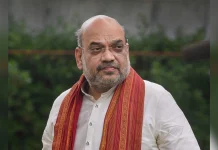In an assembly of 117 seats, the best-case scenario for the Bharatiya Janata Party (BJP) under Prime Minister Narendra Modi’s leadership is four to six seats, or if some political miracle were to descend from the ‘ghee and butter’ heavens, perhaps, eight, and therefore, they are nowhere in the reckoning this week as the state goes to polling on February 20, not even as a potential kingmaker.
By Tushar Gupta
However, that is the story of this week and of the elections gone by, for Punjab has been an outlier when it comes to the Modi wave, be it 2014, 2017, or 2019.
Modi has won the nation without winning the state of Punjab. In 2014, the BJP registered negative growth in their vote share. Of the two seats they won, one of them, that of Hoshiarpur, came with a margin of merely 13,000 votes. Gurdaspur, where late actor Vinod Khanna registered a phenomenal victory with a margin of more than 135,000 votes, was later lost to the Congress in a by-election after the actor’s demise in 2017.
It only worsened in the 2017 state assembly elections, with the party managing only 5-odd per cent of the votes. Of the 23 seats they contested on, they won merely 3, as they sunk along with the Shiromani Akali Dal (SAD), due to what many recall as the ten years of misrule, corruption, and faltering economic growth.
Yet, in 2019, after almost two years of the Congress government in the state under Captain Amarinder Singh, the political mood was beginning to favour the BJP. Having always played the second fiddle to the SAD in the state, the BJP had never been accepted as an independent party, and while the national election was fought in the same alliance, there was a greater degree of acceptance for the BJP, as evident by their victory in two of the three seats they contested on.
The remaining ten seats of the state the SAD contested on, they won merely two. For the first time, people wanted BJP to contest more seats, to play a more active role in the state politics, and to much dismay of the Akalis, wanted BJP to assert itself at the expense of its oldest ally. The yearning for change that is being confused as support for the Aam Aadmi Party (AAP) on the ground today was indeed for the BJP. Assuming, in another universe, if the issue of the three progressive farm laws had not taken a turn for the economic worst, and the Akalis had not walked out od the NDA, BJP would have contested at least 40 of the 117 seats in the state, against the 23 they were given in 2017.
Unfortunately, for the BJP, that window is now lost. The momentum and credibility they registered in the mind of a few voters, at least in the constituencies they managed to win, is now lost.. The bet on Captain Amarinder Singh has failed to pay off, who has been more fixated on attacking Navjot Singh Sidhu than offering a vision for the economic and social growth of the state. The anger from last year, pertaining to the three progressive farm laws, is still visible, and the emergence of AAP as the single largest party may warrant a strategic vote transfer on the ground, inconspicuously, towards the Congress, as was the case in 2017.
Yet, all is not lost, and the BJP should continue to play the long game in Punjab, looking at the national elections in 2024 or the future state assembly elections that may happen as early as six months later itself. A few political realities work in the favour of the BJP, even if it’s reduced to the lower single digits in this election.
One, no other party in the state, going forward, can unite the Hindu and Sikh votes as the BJP can. Even within the two communities, to take along the upper-caste Hindu vote, Hindu-Dalit vote, and the Jat-Sikh vote is something the party can alone manage. Akalis may have the support of Jat-Sikhs today, but the Hindu vote will only turn against them post their walkout from the NDA alliance, and therefore they will eventually return to the NDA fold.
Congress never had the majority vote of the Jat Sikhs, and whatever Hindu vote gravitated towards them had more to do with the Captain’s persona than the party’s politics. AAP, given its questionable acquaintances with some elements, are not in a position to unite the vote bank either. Post this election, the voting dynamics within the Hindu and Sikh community will change, and that is where the BJP must realise its new window of opportunity.
The RSS has an elaborate network in Punjab, unlike the BJP, and that network would be indispensable for Modi when it comes to reaching out to Hindus who make up 40-odd per cent of the state’s population, a good enough number to turn any election on its head.
Two, no other party but the BJP has a sound economic model for the state, and in their defence, they did market it well, just not well enough. During the few months of railway blockade in Punjab in 2020, before the farmers decided to camp along the Grand Trunk Road before constructing a mini-city in Singhu, several cabinet ministers toured Punjab to explain the importance of the three farm laws to the state. However, in the context of Punjab, politics is temporary, but the inevitability of an ecological disaster is permanent.
Freebies, as being promised by the AAP or showered by the Congress government under CM Channi, or a prolonged MSP promise cannot rescue the state from its dire financial situation, nor it can enable private sector participation and investments.
The three progressive farm laws were a shot for the state to improve its agricultural economy by getting rid of the water-intensive crops, wheat and paddy, that currently make up for 80 per cent of the cultivated land in the state, enable investments in technology and farming equipment for smaller farmers, have private sector work on infrastructure pertaining to cold storage and logistics, and given the geography and location of the state, link it with the markets of Jammu, Kashmir, Himachal Pradesh, Haryana, and transform the state into an agricultural export hub.
Today, the people of Punjab may wish to reject sound economic policies for freebies or the wisdom of Diljit Dosanjh, but going forward, the state’s agricultural economy would warrant private sector investment to boost employment, industrialization, and economic growth, and as of today, we see no major party on the ground, be it AAP, Congress, or SAD-BSP, offering that vision.
Three, the BJP has woken up to the changing dynamics in the state. Yes, a bit late for this election, but nevertheless, they have started knocking on the right doors. On his recent visit to the state, Home Minister Amit Shah held a closed-door meeting with the officiating Jathedar of the Akal Takht. Occupying the highest temporal seat for the Sikhs, the Jathedar has been closer to the SAD than any other parties in the state, going as far as linking the strength of the Akal Takht to the strength of the SAD.
In Delhi, the Prime Minister recently met Baba Gurinder Singh Dhillon of the Radha Soami Satsang Beas. The state of Punjab has as many as religious 9,000 Deras, of which four are the most significant, namely the Dera Sacha Sauda, Radha Soami Satsang Beas, Dera Sachkhand Ballan, and Bhaniarawala Dera.
These Deras usually distance themselves from the politics of the day, but in each election, they do play an instrumental role in the outcome. Only a few days ago, the head of the Dera Sacha Sauda, serving a sentence for murder and rape cases, was given a 21-days furlough, inviting a backlash from the SGPC and other parties in the state. The Deras are critical in enabling an undercurrent for or against the parties in the state.
In the current election, the BJP has been undone by its handling of the farmers’ protests, but going forward, the BJP must use its political leverage in the Centre and amongst the voters in the state, its state economic models from Uttar Pradesh, Gujarat, Haryana, etc, and its outreach to critical groups to cement its position as a formidable player in the state from being a second fiddle previously.
Ideally, to have the Akalis back in the NDA fold will only draw them closer to the SGPC and the Akal Takht, and more importantly, ensure close to 20-odd percent of the vote in the state, loyally committed to the Badals.
The BJP, and its supporters, must not expect any miracles this weekend when the state goes to polling, but beyond March 10, the party has nothing to lose and everything to win.
This article first appeared in www.swarajyamag.com and it belongs to them.








